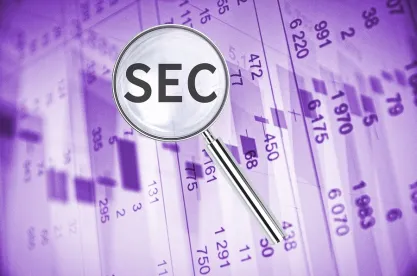Seeks to Reduce Burdens on Registrants and Improve Readability of Disclosure Documents
On October 11, 2017, the U.S. Securities and Exchange Commission (“SEC”) proposed amendments to Regulation S-K that are designed to reduce burdens on registrants and that would also impose additional requirements intended to improve readability of disclosure documents.
Among the proposed changes designed to reduce disclosure burdens:
-
MD&A. When financial statements in a filing cover three years, a discussion in Management’s Discussion and Analysis of Financial Condition and Results of Operations (“MD&A”) about the earliest year would not be required if not material and as long as the registrant has filed its prior year Form 10-K on EDGAR containing MD&A covering that earliest year. Registrants would still be required to address financial statement trends when material. Parallel changes are proposed for foreign private issuers filing on Form 20-F.
-
Exhibits. Several changes are proposed with respect to exhibits required to be filed with the SEC:
-
Confidential information. With respect to material contracts required to be filed as exhibits pursuant to Item 610(b)(10), registrants would be permitted to omit confidential information in the contract if the information is not material and would be competitively harmful if publicly disclosed, without submitting a confidential treatment request to the SEC. The proposed rule would state that the SEC’s staff may ask the registrant to provide its materiality and competitive harm analyses on a supplemental basis, and that the staff may request the registrant to amend its filing if the staff does not concur with the analyses.
-
Exclusion of schedules. As currently expressly permitted with respect to material plans of acquisition or disposition required to be filed as exhibits pursuant to Item 601(b)(2), the revised rules would allow registrants to omit schedules or similar attachments to all types of exhibits, unless they contain information material to investors that is not disclosed in the agreement or disclosure document.
-
Elimination of two-year look back. Currently, Item 610(b)(10)(i) requires registrants to file as exhibits contracts not made in the ordinary course of business, if the contract is material and either (1) is to be performed at or after the filing of the registration statement or report or (2) was entered into not more than two years before the filing. The proposed amendments would eliminate the two-year look back provision, except for newly reporting registrants.
-
Personally Identifiable Information. The proposed rules would also codify current staff practice allowing registrants to omit personally identifiable information from exhibits.
-
Foreign private issuers. Comparable exhibit changes are proposed for foreign private issuers filing on Form 20-F.
-
Description of properties. Property descriptions would be required only to the extent material to the registrant. However, the existing specialized property disclosures for oil and gas, mining and real estate industries are not proposed to be amended by these rule changes.
Among the proposed changes intended to improve the readability of disclosure documents:
-
Description of securities. Currently, a description of securities is required only in registration statements. The proposed rules would require that descriptions of the registrant’s outstanding securities registered under Section 12 of the Securities Exchange Act of 1934 be filed as exhibits to Form 10-K.
-
Omitting item numbers and captions. Registrants would be permitted to exclude item numbers and captions in Forms 10, 10-K and 20-F, other than those captions expressly required, such as “risk factors.” Instead, registrants may use their own headings and captions to facilitate clear disclosure.
-
Prohibition of incorporation by reference into financial statements. Incorporation by reference of information from outside of the financial statements into the financial statements would be prohibited, unless expressly permitted or required by other SEC rules, in order to address the concern that this practice can raise questions as to the scope of the auditor’s responsibilities.
-
Tagging of cover page data points. All data points on the cover pages of Forms 10-K, 10-Q, 8-K, 20-F and 40-F (when Forms 20-F and 40-F are used as annual reports) would be required to appear in HTML format and be tagged in Inline XBRL. (If the previously proposed Inline XBRL rules are not adopted, registrants would be required to tag each cover page data point in an XBRL exhibit to the filing.)
-
Other cover page changes. The cover pages of Forms 10-K, 10-Q, 8-K, 20-F and 40-F would be required to include the trading symbol for each class of registered securities, and the cover pages of Forms 10-Q and 8-K would also be required to contain the title of each class of registered security and the name of each exchange on which they are registered. The checkbox on the cover page of Form 10-K relating to Item 405 disclosures (Section 16 filing delinquencies) would be eliminated, although the substantive disclosure would still be required.
-
Disclosure of legal entity identifiers. In the list of subsidiaries required to be filed as an exhibit to Form 10-K and registration statements, registrants would be required to disclose legal entity identifiers (“LEIs”) for the registrant and each listed subsidiary, if already obtained by the registrant. An LEI is a 20-character, alpha-numeric code that allows for unique identification of entities engaged in financial transactions.
Several technical changes are proposed relating to the cover pages of prospectuses and the elimination of certain undertakings in registration statements. The SEC release also includes some parallel proposed changes applicable to investment companies and investment advisers, which are not summarized in this report.
Comments are due 60 days after publication of the proposed rule amendments in the Federal Register. The proposed rule changes are part of the SEC’s long-standing “disclosure effectiveness” effort and are also in response to requirements in Section 72003 of the December 2015 FAST Act. If the amendments are adopted substantially as proposed, in addition to the changes described above, there will be other technical changes to implement which, while relatively minor, are numerous. Therefore, registrants should stay tuned for further developments.




 />i
/>i

